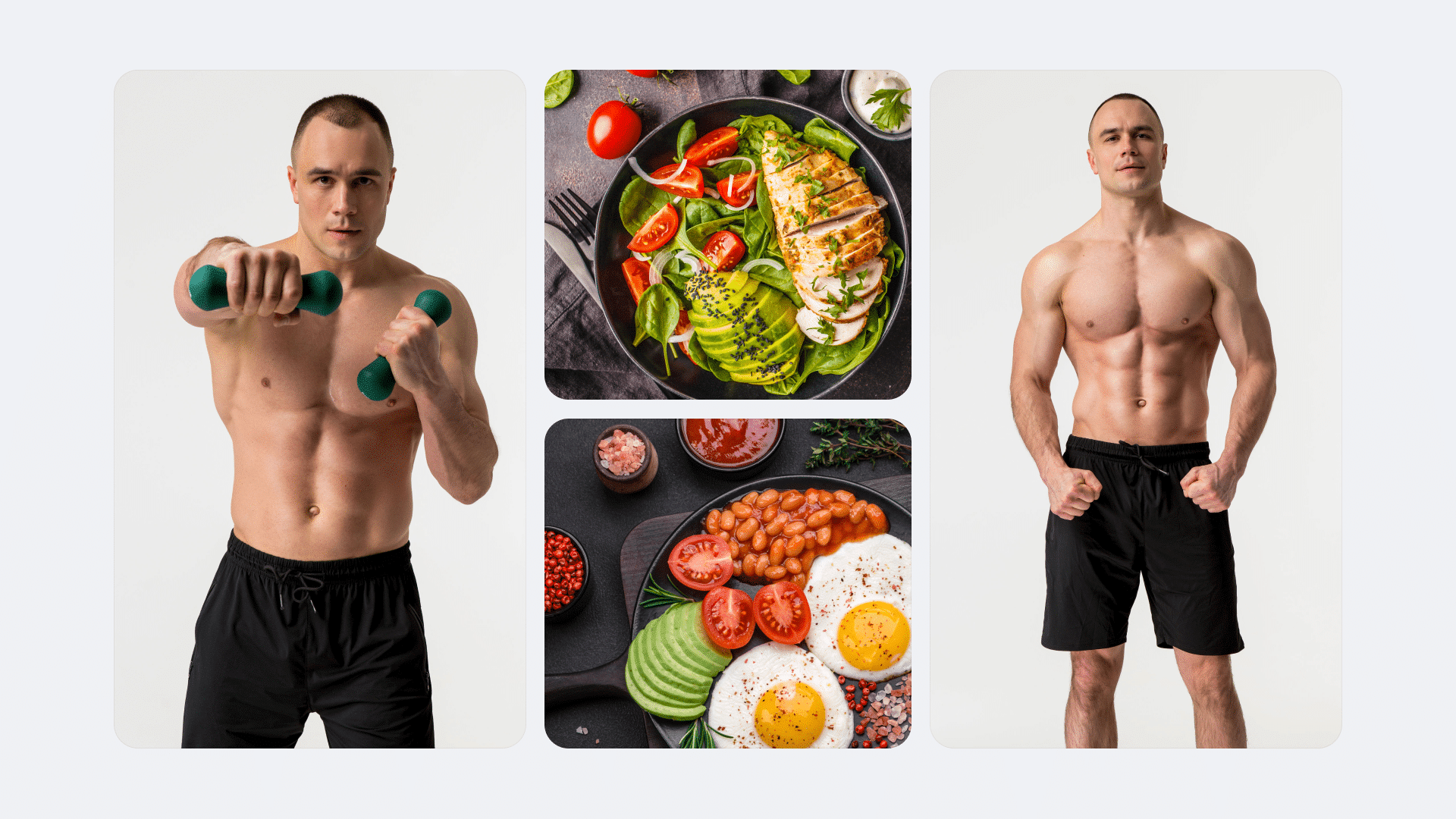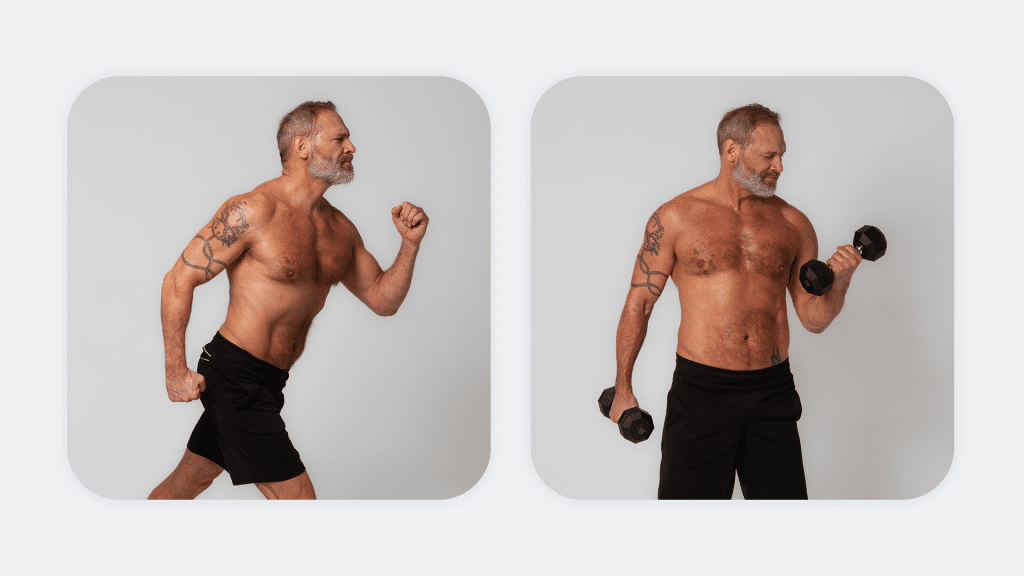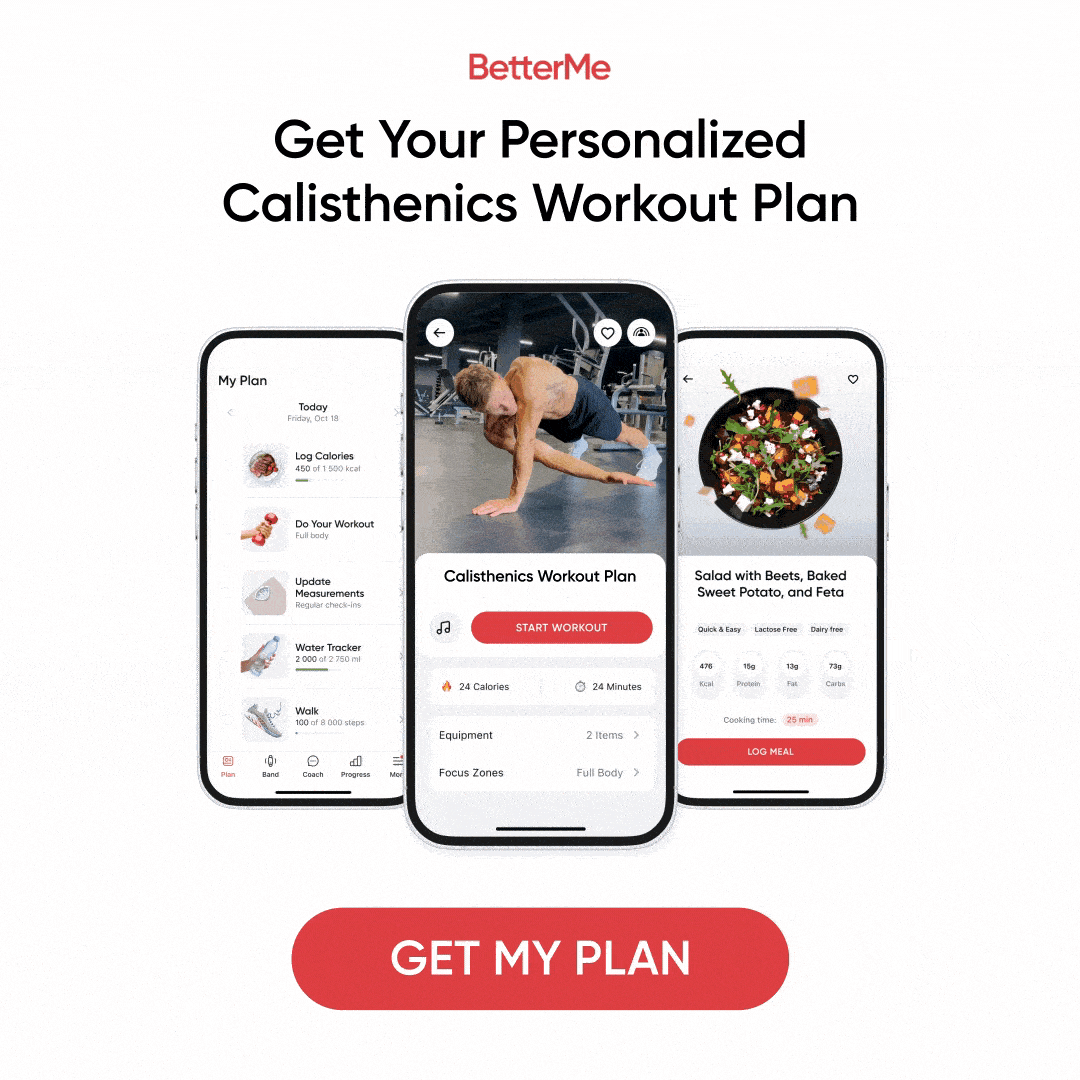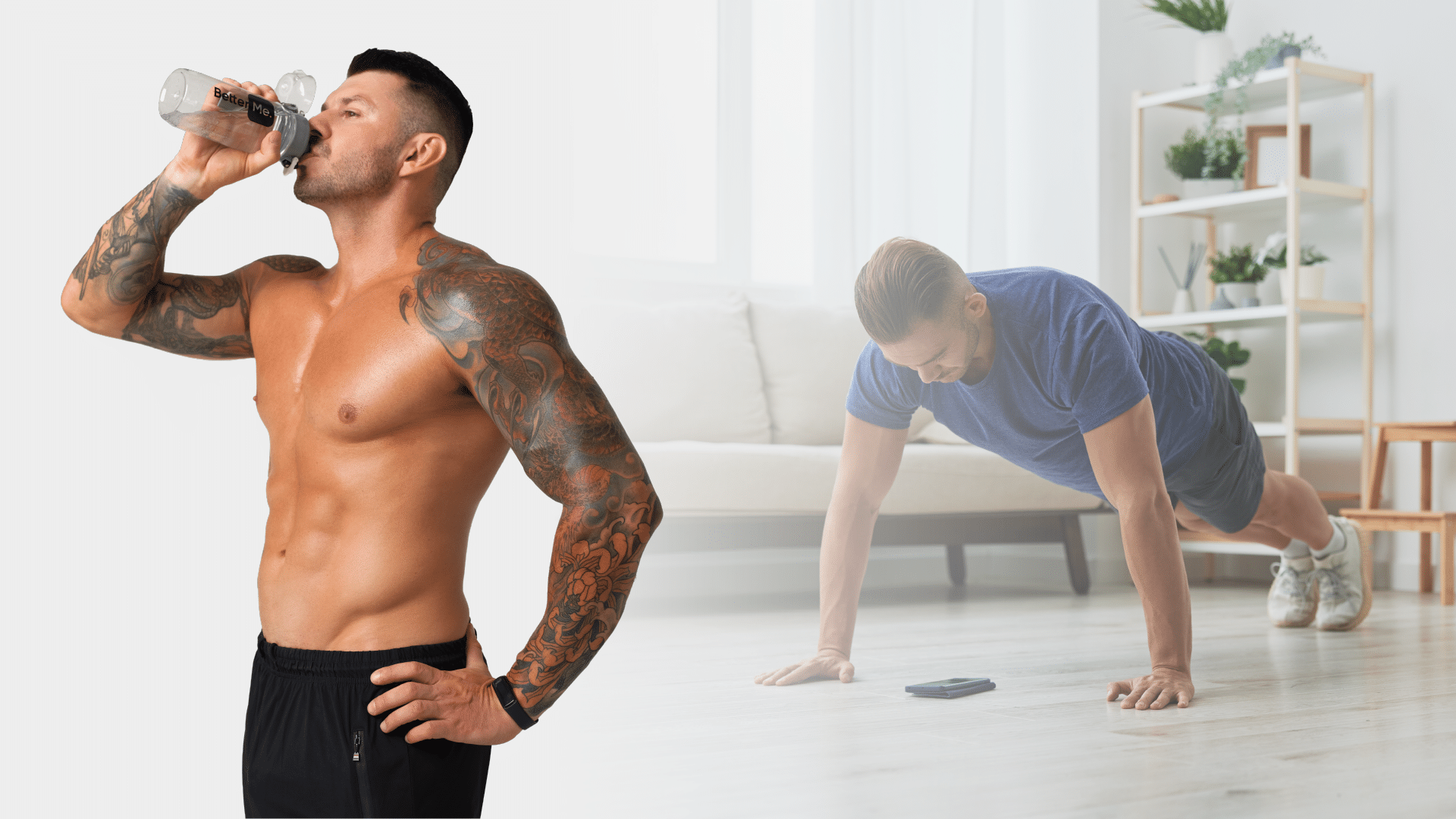Food is fuel, particularly when it comes to calisthenics. The art of using your own body weight to achieve fitness goals requires dedication and discipline in training, in addition to a keen understanding of nutrition.
This guide is designed to shed light on how the right diet can significantly enhance your performance, speed up recovery, and help you sculpt a physique that is both resilient and robust.
We will explore how a nutrient-rich diet can optimize your energy levels, increase muscle growth, and help with efficient fat loss.
By understanding the principles of the calisthenics diet, you will be able to make informed decisions about what and when you eat, which will ultimately maximize your potential in calisthenics training.
What Is The Best Diet for Calisthenics?
The best diet for calisthenics is one that is balanced and rich in protein, complex carbohydrates, and healthy fats. This is because calisthenics involves strenuous physical activities that require a significant amount of energy, endurance, and muscle strength.
Protein is vital as it helps with muscle recovery and growth, which is essential for those who perform calisthenics regularly (9). Foods such as lean meats, eggs, fish, and plant-based proteins such as lentils and tofu are all excellent sources.
Complex carbohydrates serve as the primary energy source during workouts (6). They are slow-digesting, which ensures a steady release of energy throughout the training session. They can be found in foods such as whole grains, fruits, vegetables, and legumes.
At the same time, healthy fats play a crucial role in hormonal balance and inflammation control, both of which are essential for overall health and fitness (5). Avocados, nuts, seeds, and fatty fish are excellent sources of healthy fats.
In addition, remaining hydrated is of equal importance. Water helps maintain body temperature, lubricate joints, and helps transport nutrients to give you the energy and stamina you require for performing your exercises (10).
It is important to remember that this diet should be tailored to your specific needs, depending on your body type, fitness level, and calisthenics goals.
If you wish to free yourself from all the extra pounds that have been weighting you down for way too long, start using the BetterMe app and overhaul your entire life!
By “tailored to your specific needs”, we mean:
A tailored calisthenics diet should consider individual characteristics such as age, gender, current weight, goal weight, and activity level.
For example, if you’re trying to lose weight, you must consume fewer calories than you burn in your workouts, but these calories must also be nutrient-dense to support muscle repair and growth. Conversely, if your goal is to gain muscle mass, you must consume more calories, particularly protein, to support muscle development.
Furthermore, your diet should be aligned with the intensity and the types of calisthenics you do. If you engage in high-intensity workouts, you will require more carbohydrates to fuel your sessions, while those who do strength-based exercises may require more protein to aid muscle recovery and growth.
Finally, lifestyle and dietary preferences should be considered. For example, if you’re a vegetarian or vegan, you will need to find plant-based protein sources. If you have a busy schedule, you may want meals and snacks that are easy to prepare and portable.
Essentially, a tailored calisthenics diet is not a one-size-fits-all situation. It should be adjusted according to your specific requirements and circumstances in order to ensure you receive the right nutrients in the right quantities at the right times, which will maximize your performance and results.
How Do Calisthenics Athletes Eat?
Calisthenics athletes follow a well-rounded diet that is high in protein, balanced with complex carbohydrates, and incorporates healthy fats. This type of diet supports the rigorous bodyweight training routines they engage in and facilitates muscle recovery and growth.
Typical calisthenics meal prep may involve planning meals for the week to ensure a consistent intake of necessary nutrients. This can include lean meats such as chicken or fish, plenty of fresh vegetables for fiber and vitamins, and complex carbs such as brown rice or quinoa for sustained energy.
Calisthenics recipes are often simple, with a focus on whole foods and natural ingredients. An example is a grilled chicken salad with a variety of colorful vegetables, or a protein-packed smoothie with fruits, spinach, and a scoop of protein powder.
For calisthenics breakfast, athletes may opt for eggs due to their high protein content, combining them with whole grain toast and a piece of fruit for a balanced start to the day.
Even those who practice calisthenics without a strict diet focus on wholesome, nutrient-dense foods to support their workouts. The key is to fuel the body adequately for the physical demand of calisthenics workouts.
Similar to a calisthenics diet plan, a bodyweight training diet emphasizes the importance of protein for muscle repair, carbs for energy, and fats for overall health. A calisthenics diet meal plan should include three balanced meals and a couple of snacks to ensure energy levels are maintained throughout the day.
It should be noted that a calisthenics vegetarian diet plan is also entirely possible. Plant-based proteins such as lentils, chickpeas, tofu, and tempeh can be used to replace animal proteins, and a wide variety of fruits, vegetables, grains, and nuts can provide all the essential nutrients you need.
Sample Calisthenics Diet Meal Plan
Here’s a sample calisthenics meal plan you can follow:
Breakfast:
- Overnight oats topped with fresh fruits and a sprinkle of chia seeds
- A three-four egg omelet with spinach, tomatoes, and bell peppers
- Protein shake with a banana and a spoonful of almond butter
- Whole grain toast topped with avocado and poached eggs
Mid-Morning Snack:
- A smoothie made with banana, spinach, a scoop of protein powder, and almond milk
- A handful of nuts and seeds
- Greek yogurt with honey and mixed berries
- A piece of fruit such as an apple or a banana
- Hummus with carrot and cucumber sticks
Lunch:
- Grilled chicken breast served with a quinoa salad (quinoa, bell peppers, cherry tomatoes, cucumber, and a vinaigrette)
- Quinoa salad with chickpeas, cucumber, tomatoes, and feta cheese
- Tuna sandwich on whole wheat bread with a side of mixed greens
- Bean salad with corn, tomato, avocado, and lime dressing
Afternoon Snack:
- A handful of mixed nuts and berries
- Protein bar or a protein shake
- Cottage cheese with pineapple chunks
- Celery sticks with peanut butter
Dinner:
- Baked salmon with a side of steamed broccoli and sweet potato
- Lean steak with quinoa and grilled asparagus
- Stir-fried tofu with mixed vegetables and brown rice
- Baked chicken breast with a side of roasted Brussels sprouts and wild rice
Evening Snack (Optional):
- Greek yogurt with a drizzle of honey and a sprinkle of chia seeds
- A cup of low-fat milk or a milk alternative
- A piece of dark chocolate
- A small bowl of mixed berries
- A handful of popcorn
This meal plan ensures a balanced intake of protein, complex carbohydrates, and healthy fats. It is designed to fuel your workouts, help muscle recovery and growth, and support overall health.
It is important to remember that quantities should be adjusted based on your caloric needs and fitness goals. This meal plan can also be used in combination with bodyweight exercises to help achieve a lean physique.
Read more: Pilates vs Calisthenics: Which Workout is More Effective for Toning and Sculpting?
How Many Calories Should I Eat Doing Calisthenics?
The number of calories you need to eat while doing calisthenics is dependent on several factors such as age, gender, weight, height, and workout intensity.
Generally, an average man requires approximately 2,500 calories each day in order to maintain his weight, and an average woman requires approximately 2,000 calories (1). However, if you’re doing calisthenics, a form of high-intensity workout, you may require more calories to fuel your workouts and support muscle recovery and growth.
If you’re doing calisthenics as a means of losing weight, you may wish to create a calorie deficit, meaning that you consume fewer calories than you burn. A deficit of 500 to 750 calories each day can lead to a safe and healthy weight loss of 1-2 pounds per week (2).
However, if your aim is to gain muscle mass, you’ll need to be in a calorie surplus, which means consuming more calories than you burn. This surplus can range from 250 to 500 extra calories each day on top of your maintenance calories.
You should remember that these are just general guidelines and individual calorie needs can vary greatly, so it is always best to consult a registered dietitian for personalized advice.
In addition, not all calories are created equal, so you should focus on consuming nutrient-dense foods that provide plenty of lean protein, complex carbohydrates, and healthy fats, rather than simply focusing on the number of calories.
Do Calisthenics Athletes Eat a Lot?
Calisthenics athletes often require a higher calorie intake than the average person due to the intense nature of their training. However, the frequency of meals can vary significantly, depending on personal preference, lifestyle, training schedule, and specific goals.
What is most important is that the athlete gets enough calories and nutrients to fuel their training and recovery.
Here’s a breakdown of meal frequency options that may be chosen by calisthenics athletes:
Three Main Meals a Day
Some athletes stick to the traditional structure of breakfast, lunch, and dinner. Their meals are generally larger and more calorie-dense in order to satisfy their energy needs.
Pros:
- Easier to plan and prepare
- May align better with family or work schedules
Cons:
- May lead to feeling overly full after meals
- Longer periods without food can lead to energy dips
Five to Six Smaller Meals a Day
Many athletes prefer to eat smaller meals more regularly throughout the day (every 2-3 hours). This can help maintain steady energy levels while also managing hunger.
Pros:
- More consistent energy supply for workouts and recovery
- Can prevent overeating by curbing excessive hunger
Cons:
- Requires more time and planning
- May be difficult to fit into a busy schedule
Intermittent Fasting
Some calisthenics athletes may follow an intermittent fasting protocol, in which they eat all meals within a certain time window each day (e.g., 8 hours) and fast for the remaining hours.
Pros:
- May help with fat loss and improve metabolic health (7)
- Less time spent preparing and eating food
Cons:
- Can lead to overeating during the eating window
- May not provide consistent energy levels for training
Snacking
In addition to main meals, calisthenics athletes often include snacks as part of their diets for extra calories and nutrients. Such snacks can be particularly important before and after workouts.
BetterMe App helps you achieve your body goals with ease and efficiency by helping to choose proper meal plans and effective workouts. Start using our app and you will see good results in a short time.
Should I Do Calisthenics On an Empty Stomach?
There are pros and cons to doing calisthenics on an empty stomach, also known as fasted training. Here are some points worth considering:
Pros
- Increased Fat Burning: Exercising on an empty stomach may help increase fat burning as your body must turn to stored fat for energy if there is no food in your system (4).
- Enhanced Metabolic Function: Fasted workouts can potentially boost your metabolic function, although more research is needed (3).
- Improved Brain Function: Some people find working out on an empty stomach to enhance focus and creativity.
- Feeling of Lightness: Some individuals feel lighter and more agile when they exercise without having eaten.
Cons
- Reduced Energy Levels: Without a source of immediate energy from food, your workout performance may suffer. You may be unable to train as intensely or for as long as you can when you have eaten.
- Risk of Muscle Loss: If your body runs out of stored glycogen (a form of energy) during a fasted workout, it may start to break down muscle tissue for fuel, which is not ideal if your goal is building strength and muscle mass.
- Potential for Overeating Later: Some people may find themselves overeating after a fasted workout due to the feeling of extreme hunger.
- Not Suitable for Everyone: A fasted bodyweight workout plan may not be suitable for everyone, particularly those with medical conditions such as diabetes or hypoglycemia.
Whether or not to do calisthenics on an empty stomach is a personal decision and what works best for you will be dependent on your individual body, goals, and how you feel during your workouts. It could be beneficial to experiment with both fasted and fed workouts to determine which type suits you best.
Read more: Calisthenics Pull Ups: A Step-by-Step Guide for Beginners.
Frequently Asked Questions
Why are calisthenics athletes so lean?
People who regularly do calisthenics often appear lean as this type of training involves high-intensity, full-body movements that burn a large amount of calories.
Calisthenics exercises utilize body weight as resistance, which promotes the development of lean muscle mass rather than bulk.
In addition, many individuals who practice calisthenics follow healthy, balanced diets that support fat loss and muscle definition. Calisthenics without a proper diet may not have the same effect.
How much protein do I need for calisthenics?
Protein requirements can vary according to your body weight, goals, and the intensity of your calisthenics routine.
As a general guideline, many fitness and health experts suggest a daily protein intake of 1.4 to 2 grams per kilogram of body weight for those who engage in regular strength training such as calisthenics (8).
This means if you weigh 70 kilograms (154 pounds), you will require between 98 and 140 grams of protein each day. It is best to spread your protein intake throughout the day for optimal absorption and muscle recovery.
Is 120g of protein enough For muscle building?
A daily intake of 120g of protein is sufficient for muscle building for many individuals, but it is dependent on a variety of factors such as body weight, training intensity, and overall calorie intake.
Generally, if you weigh around 60-75 kilograms (132-165 pounds), 120g of protein will be enough to support muscle growth as long as you also consume an adequate number of total calories and get sufficient rest and recovery. However, individual needs can vary, so it is generally best to seek personalized advice from a health or fitness professional.
The Bottom Line
The calisthenics diet is all about providing your body with fuel in the form of the correct nutrients for optimal performance and recovery. Understanding the importance of balanced meals, protein intake, meal timing, and hydration can significantly improve your calisthenics training and results.
By embracing a diet that is as disciplined and dynamic as your workout routine, you will witness a transformation in your strength, stamina, and physique.
DISCLAIMER:
This article is intended for general informational purposes only and does not address individual circumstances. It is not a substitute for professional advice or help and should not be relied on to make decisions of any kind. Any action you take upon the information presented in this article is strictly at your own risk and responsibility!
SOURCES:
- Calories (2022, ncbi.nlm.nih.gov)
- Dietary intakes associated with successful weight loss and maintenance during the Weight Loss Maintenance Trial (2012, ncbi.nlm.nih.gov)
- Effects of fasted vs fed-state exercise on performance and post-exercise metabolism: A systematic review and meta-analysis (2018, pubmed.ncbi.nlm.nih.gov)
- Exercising in the Fasted State Reduced 24-Hour Energy Intake in Active Male Adults (2016, hindawi.com)
- Fats and Other Lipids – Diet and Health (1989, ncbi.nlm.nih.gov)
- High-Quality Carbohydrates and Physical Performance (2018, journals.lww.com)
- Intermittent Fasting and Metabolic Health (2022, mdpi.com)
- International Society of Sports Nutrition position stand: protein and exercise (2007, ncbi.nlm.nih.gov)
- Protein for exercise and recovery (2009, pubmed.ncbi.nlm.nih.gov)
- Water, hydration, and health (2010, academic.oup.com)















